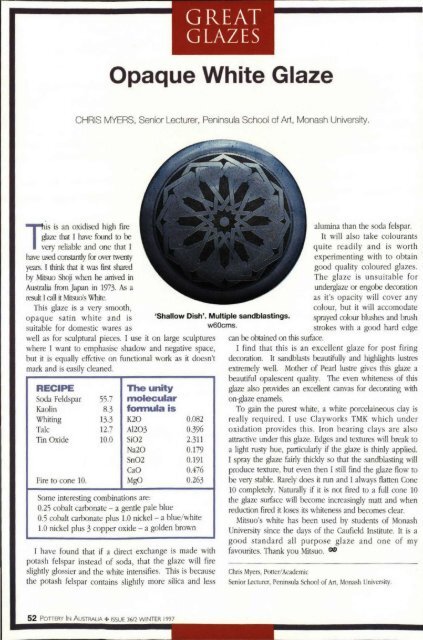Pottery In Australia Vol 36 No 2 Winter 1997
Create successful ePaper yourself
Turn your PDF publications into a flip-book with our unique Google optimized e-Paper software.
GREAT<br />
GLAZES<br />
Opaque White Glaze<br />
CHRIS MYERS, Senior Lecturer, Peninsula School of Art, Monash University.<br />
is an oxidised high fIre<br />
alumina than the soda felspar.<br />
glaze thar I have found to be<br />
It will also take colourants<br />
-n'is<br />
very reliable and one that I<br />
quite readily and is worth<br />
have used CO!1SIal1t1y for over twenty<br />
experimenting with to obtain<br />
year.;. I think thar it was fir.;( shared<br />
good quality coloured glazes.<br />
by Mitsuo Shoji when he anived in<br />
The glaze is unsuitable for<br />
<strong>Australia</strong> from Japan in 1973. As a<br />
underglaze or engobe decoration<br />
result I call it Mitsuo's Whire.<br />
as it's opacity will cover any<br />
This glaze is a very smooth,<br />
colour, but it will accomodare<br />
opaque satin white and is 'Shallow Dish'. Multiple sandblastings. sprayed colour blushes and brush<br />
suitable for domestic wares as w60cms. strokes with a good hard edge<br />
well as for sculptural pieces. I use it on large sculptures can be obtained on this surface.<br />
where I lVant to emphasise shadow and negative space, I find that this is an excellent glaze for post firing<br />
but it is equally effctive on functional work as it doesn't decoration. It sandblasts be-dutifully and higlliights lustres<br />
mark and is easily cleaned. extremely weU. Mother of Pearl lustre gives this glaze a<br />
beautiful opalescent quality. TIle even whiteness of this<br />
RECIPE<br />
1l1e lUlity<br />
glaze also provides an excellent canvas for decorating with<br />
Soda Feldspar 55.7 molecular<br />
on·gIaze enamels.<br />
Kaolin 83 fonnula is<br />
To gain the purest white, a white porcelaineous clay is<br />
Whiting 13.3 K20 0.082 really required. I use Clayworks TMK which under<br />
Talc 12.7 Al203 0.396 oxidation provides this. Iron bearing clays are also<br />
Tin Oxide 10.0 Si02 2.311 attractive under dlis glaze. Edges anJ textures will break to<br />
a20 0.179 a light rusty hue, particularly if the glaze is thinly applied.<br />
Sn02 0.191 I spray the glaze fairly thickly so that the sandblasting will<br />
eaO 0.476 produce texture, but even then I still find the glaze flow to<br />
Fire to cone 10. MgO 0.263 be very stable. Rarely does it run and 1 always flatten Cone<br />
10 completely. Naturally if it is not tired to a full cone 10<br />
Some interesting combinations are:<br />
the glaze surface will become increasingly matt and when<br />
0.25 cobalt carbonate - a gende pale blue<br />
reduuion fIred it loses its whiteness and becomes clear.<br />
0.5 cobalt carbonate plus 1.0 nickel - a blue/white Mitsuo's white has been used by students of Monash<br />
1.0 nickel plus 3 copper oxide - a golden brown University since the days of the Caufield <strong>In</strong>stitute. It is a<br />
good sta ndard all purpose glaze and one of my<br />
favourites. Thank you Mitsuo. 00<br />
I have found that if a direct exchange is made with<br />
potash felspar instead of soda, that the glaze will fire<br />
slightly glOSSier and dle white intensifies. This is because<br />
the potash felspar contains slightly more silica and less<br />
Chris Myers, POller/ Academic<br />
Senior Lecturer, Peninsula School of An, Monash University.<br />
52 POTIERY IN AUSTRAUA + ISSUE 31/2 WlNTER <strong>1997</strong>


















